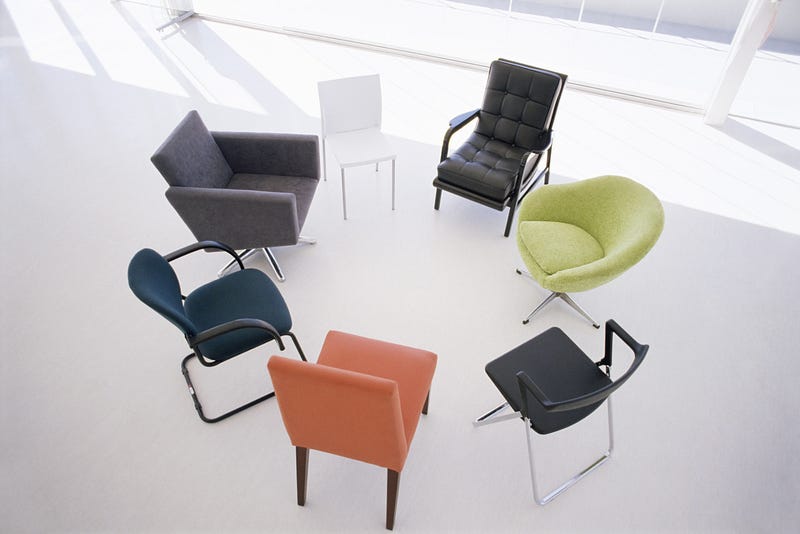Could Adjusting Your Chair Really Extend Your Lifespan?
Written on
The Impact of Sitting on Health
The distinction between sitting and "active resting" is substantial. Research suggests that merely altering how we sit could potentially add years to our lives.

Despite my academic background, my experiences with back pain have made me personally invested in this topic. To promote a more active way of sitting, I even founded a company (QOR360) dedicated to creating chairs designed for active sitting. While this may raise questions about bias, I believe the evidence is compelling.
A recent article titled "Changing the Way You Sit Could Add Years to Your Life" appeared in New Scientist, presenting a striking claim that, if substantiated, could significantly alter daily routines for many. However, as Carl Sagan noted, "extraordinary claims require extraordinary evidence."
David Raichlen, a prominent researcher from the University of Southern California, authored the paper. His research focuses on how humans evolved to need exercise for optimal health and how our modern sedentary lifestyles undermine longevity. Raichlen's anthropological approach, which draws insights from contemporary hunter-gatherers, offers a unique perspective on our current situation.
Raichlen articulates the conundrum: "We've long known that sedentary jobs and lifestyles correlate with higher heart disease and mortality rates. But why is that?"
He probes deeper than just the biochemical effects of prolonged sitting, which are already well-documented. Instead, he raises a fundamental question: "Why would evolution lead to an organism that does not thrive on rest?"
His research indicates that hunter-gatherer societies do not seem to experience the same negative effects of resting that we do in the developed world. This leads to the question: "How did we in the West manage to complicate something as straightforward as sitting?"
To explore this, Raichlen traveled to Tanzania to study the Hadza, among the last remaining hunter-gatherer groups. Surprisingly, he found that the Hadza spend approximately 10 hours a day lounging, similar to Americans and Europeans. However, their method of resting does not involve chairs. Instead, they squat comfortably on the ground.
Raichlen theorized that squatting is actually an active form of rest, requiring significant muscular engagement to maintain balance. His measurements confirmed that even while appearing relaxed, the Hadza's leg muscles were quite active. This discovery suggests that maintaining activity during rest may mitigate the adverse effects associated with complete inactivity.
Interestingly, the camp chairs brought by Raichlen's team attracted the Hadza's attention, indicating that they might also fall victim to the so-called "sitting disease" if introduced to modern office jobs. This parallel can be drawn to the introduction of tobacco to the Hadza, which has led to health issues over time. Both tobacco use and sedentary behavior can be seen as "modern maladies" that exploit human tendencies without evolutionary safeguards.
Historically, we know when humans began squatting and when Westerners ceased this practice. Raichlen's analysis of skeletal remains shows that squatting has been a human trait for at least 2 million years, while Western societies have only abandoned it in recent centuries. Our bodies have not yet adapted to our current preference for passive sitting.
This mismatch between our modern environment and our evolutionary adaptations results in numerous health issues, including obesity, diabetes, heart disease, and even cancer, leading to premature mortality. Notably, those who sit the most face a 50% increased risk of cancer. Reducing sedentary behavior could potentially extend lifespans by up to two years.
Despite these challenges, Raichlen maintains a hopeful outlook. Understanding the dynamics of our health issues related to passive sitting is crucial. He encourages us to "get up, move around, and... when you turn on Netflix, try squatting."
While I share his optimism, I doubt that many will adopt squatting as their preferred position for watching television. However, utilizing "active sitting" methods—balancing on one's sitting bones—could offer similar protective benefits against the detrimental effects of prolonged inactivity.
The Solution: Active Sitting
Human anatomy is not suited for the way we sit today, indicating a misunderstanding in our design of chairs. However, our inventive nature may lead to the development of chairs that promote active sitting, allowing us to regain the healthy blood chemistry of our ancestors. Several companies, including CoreChair, QOR360, and Swopper, are already producing chairs that facilitate movement while seated, enabling us to fulfill modern demands without enduring the adverse effects of immobility. With a few years of active sitting, we might reclaim the two years of life that passive sitting has cost us—a truly hopeful prospect.
Chapter 2: Strengthening Your Sitting Posture
This video demonstrates the Sit to Stand Strengthening Exercise, which can aid in improving posture and promoting active sitting habits.
Here, we explore "How To Get Up From A Chair With 1 Simple Trick (60+)," a useful guide for maintaining mobility and health in our daily lives.